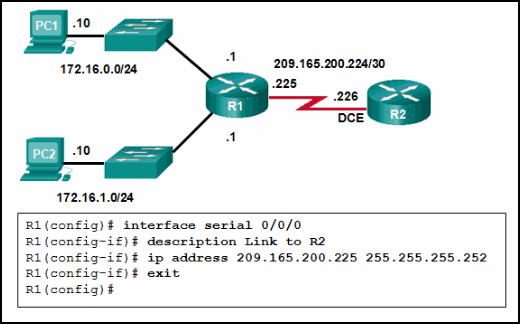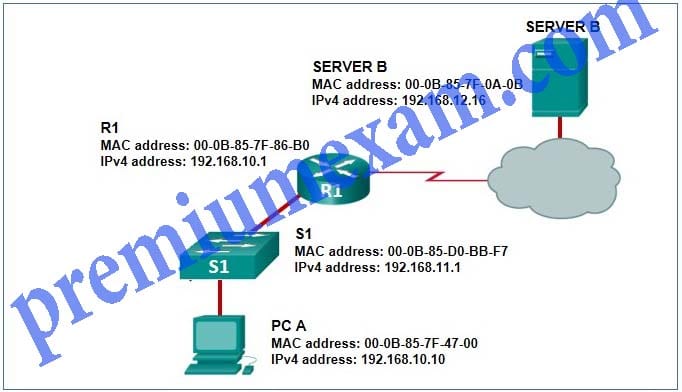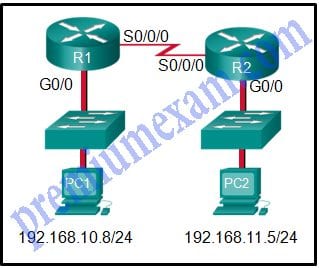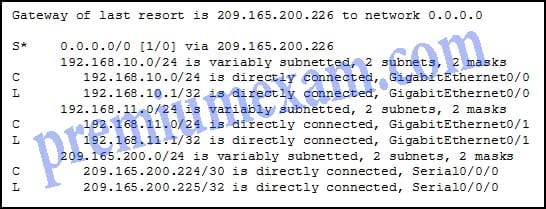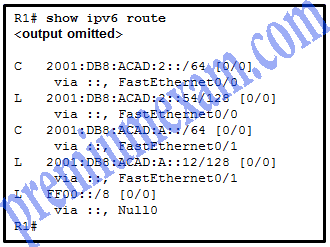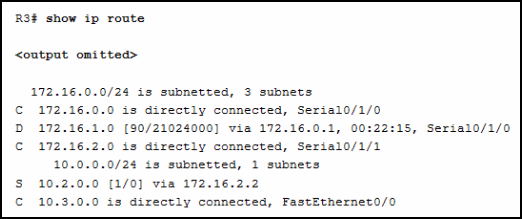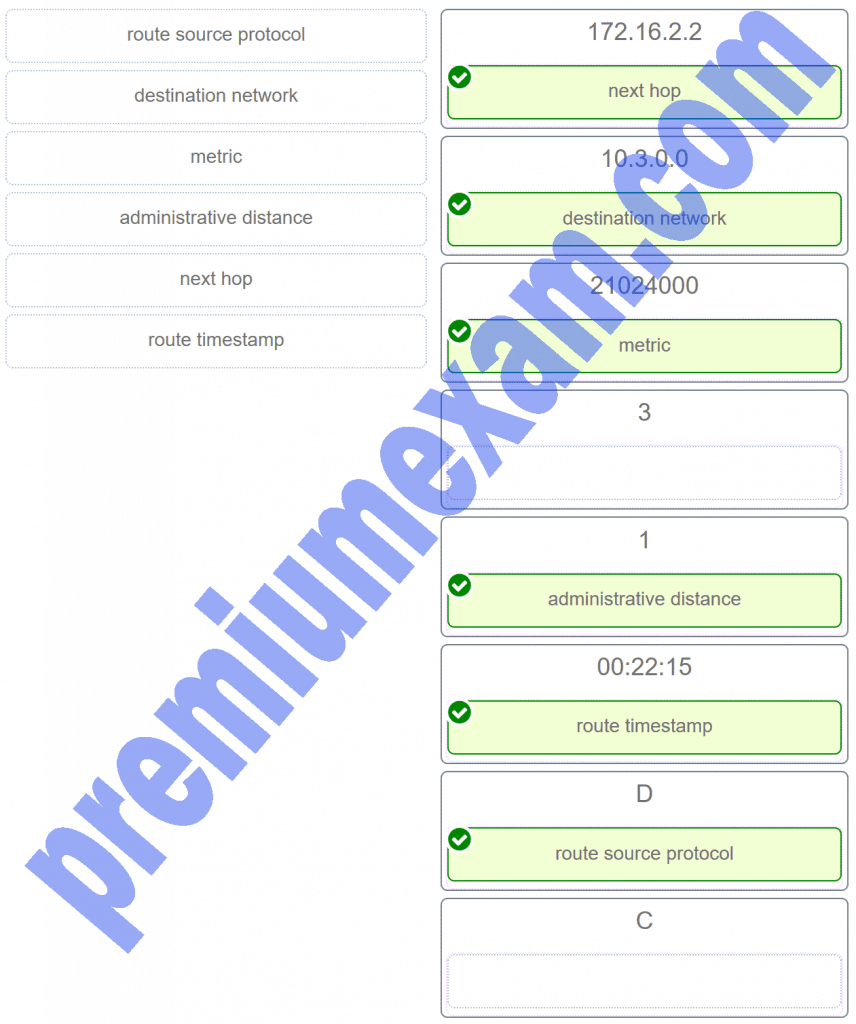Last Updated on January 14, 2021 by Admin
CCNA 2 RSE 6.0 Chapter 1 Exam Answers 2018 2019 100%
-
A network administrator enters the command copy running-config startup-config. Which type of memory will the startup configuration be placed into?
- flash
- RAM
- NVRAM
- ROM
Explanation:A router contains four types of memory: - RAM – volatile memory used to store the running IOS, running configuration file, routing table, ARP table, as well as serve as a packet buffer
- ROM – nonvolatile memory used to hold a limited version of the IOS, bootup instructions, and basic diagnostic software
- NVRAM – nonvolatile memory used to hold the startup configuration file
- Flash – nonvolatile memory used to hold the IOS and other system files
-
Which packet-forwarding method does a router use to make switching decisions when it is using a forwarding information base and an adjacency table?
- fast switching
- Cisco Express Forwarding
- process switching
- flow process
Explanation: Cisco Express Forwarding (CEF) is the fastest and preferred switching method. It uses a FIB and an adjacency table to perform the task of packet switching. These data structures change with the topology.
-
When a router receives a packet, what information must be examined in order for the packet to be forwarded to a remote destination?
- destination MAC address
- source IP address
- destination IP address
- source MAC address
Explanation: When a router receives a packet, it examines the destination address of the packet and uses the routing table to search for the best path to that network.
-
What are two functions of a router? (Choose two.)
- A router connects multiple IP networks.
- It controls the flow of data via the use of Layer 2 addresses.
- It determines the best path to send packets.
- It provides segmentation at Layer 2.
- It builds a routing table based on ARP requests.
Explanation: Routers connect multiple networks, determine the best path to send packets, and forward packets based on a destination IP address.
-
In order for packets to be sent to a remote destination, what three pieces of information must be configured on a host? (Choose three.)
- hostname
- IP address
- subnet mask
- default gateway
- DNS server address
- DHCP server address
Explanation: A host can use its IP address and subnet mask to determine if a destination is on the same network or on a remote network. If it is on a remote network, the host will need a configured default gateway in order to send packets to the remote destination. DNS servers translate names into IP addresses, and DHCP servers are used to automatically assign IP addressing information to hosts. Neither of these servers has to be configured for basic remote connectivity.
-
Which software is used for a network administrator to make the initial router configuration securely?
- SSH client software
- Telnet client software
- HTTPS client software
- terminal emulation client software
Explanation: Connecting to the router console port is required for making the initial router configuration. A console cable and terminal emulation software are needed to connect to the console port. SSH, Telnet, and HTTPS could be used to configure a router if the router has been configured with IP addresses and its interface can be reached through the network.
-
Refer to the exhibit. A network administrator has configured R1 as shown. When the administrator checks the status of the serial interface, the interface is shown as being administratively down. What additional command must be entered on the serial interface of R1 to bring the interface up?
- IPv6 enable
- clockrate 128000
- end
- no shutdown
Explanation: By default all router interfaces are shut down. To bring the interfaces up, an administrator must issue the no shutdown command in interface mode.
-
What is a characteristic of an IPv4 loopback interface on a Cisco IOS router?
- The no shutdown command is required to place this interface in an UP state.
- It is a logical interface internal to the router.
- Only one loopback interface can be enabled on a router.
- It is assigned to a physical port and can be connected to other devices.
Explanation: The loopback interface is a logical interface internal to the router and is automatically placed in an UP state, as long as the router is functioning. It is not assigned to a physical port and can therefore never be connected to any other device. Multiple loopback interfaces can be enabled on a router.
-
What two pieces of information are displayed in the output of the show ip interface brief command? (Choose two.)
- IP addresses
- MAC addresses
- Layer 1 statuses
- next-hop addresses
- interface descriptions
- speed and duplex settings
Explanation: The command show ip interface brief shows the IP address of each interface, as well as the operational status of the interfaces at both Layer 1 and Layer 2. In order to see interface descriptions and speed and duplex settings, use the command show running-config interface. Next-hop addresses are displayed in the routing table with the command show ip route, and the MAC address of an interface can be seen with the command show interfaces.
-
Which two items are used by a host device when performing an ANDing operation to determine if a destination address is on the same local network? (Choose two.)
- destination IP address
- destination MAC address
- source MAC address
- subnet mask
- network number
Explanation: The result of ANDing any IP address with a subnet mask is a network number. If the source network number is the same as the destination network number, the data stays on the local network. If the destination network number is different, the packet is sent to the default gateway (the router that will send the packet onward toward the destination network).
-
Refer to the exhibit. PC A sends a request to Server B. What IPv4 address is used in the destination field in the packet as the packet leaves PC A?
- 192.168.10.10
- 192.168.11.1
- 192.168.10.1
- 192.168.12.16
Explanation:The destination IP address in packets does not change along the path between the source and destination.
-
Refer to the exhibit.
What does R1 use as the MAC address of the destination when constructing the frame that will go from R1 to Server B?
- If the destination MAC address that corresponds to the IPv4 address is not in the ARP cache, R1 sends an ARP request.
- The packet is encapsulated into a PPP frame, and R1 adds the PPP destination address to the frame.
- R1 uses the destination MAC address of S1.
- R1 leaves the field blank and forwards the data to the PC.
Explanation: Communication inside a local network uses Address Resolution Protocol to obtain a MAC address from a known IPv4 address. A MAC address is needed to construct the frame in which the packet is encapsulated.
-
Refer to the exhibit. If PC1 is sending a packet to PC2 and routing has been configured between the two routers, what will R1 do with the Ethernet frame header attached by PC1?
- nothing, because the router has a route to the destination network
- remove the Ethernet header and configure a new Layer 2 header before sending it out S0/0/0
- open the header and replace the destination MAC address with a new one
- open the header and use it to determine whether the data is to be sent out S0/0/0
Explanation: When PC1 forms the various headers attached to the data one of those headers is the Layer 2 header. Because PC1 connects to an Ethernet network, an Ethernet header is used. The source MAC address will be the MAC address of PC1 and the destination MAC address will be that of G0/0 on R1. When R1 gets that information, the router removes the Layer 2 header and creates a new one for the type of network the data will be placed onto (the serial link).
-
Refer to the exhibit. What will the router do with a packet that has a destination IP address of 192.168.12.227?
- Drop the packet.
- Send the packet out the Serial0/0/0 interface.
- Send the packet out the GigabitEthernet0/0 interface.
- Send the packet out the GigabitEthernet0/1 interface.
Explanation: After a router determines the destination network by ANDing the destination IP address with the subnet mask, the router examines the routing table for the resulting destination network number. When a match is found, the packet is sent to the interface associated with the network number. When no routing table entry is found for the particular network, the default gateway or gateway of last resort (if configured or known) is used. If there is no gateway of last resort, the packet is dropped. In this instance, the 192.168.12.224 network is not found in the routing table and the router uses the gateway of last resort. The gateway of last resort is the IP address of 209.165.200.226. The router knows this is an IP address that is associated with the 209.165.200.224 network. The router then proceeds to transmit the packet out the Serial0/0/0 interface, or the interface that is associated with 209.165.200.224.
-
Which two parameters are used by EIGRP as metrics to select the best path to reach a network? (Choose two.)
- hop count
- bandwidth
- jitter
- resiliency
- delay
- confidentiality
Explanation: EIGRP uses bandwidth, delay, load, and reliability as metrics for selecting the best path to reach a network.
-
What route would have the lowest administrative distance?
- a directly connected network
- a static route
- a route received through the EIGRP routing protocol
- a route received through the OSPF routing protocol
Explanation: The most believable route or the route with the lowest administrative distance is one that is directly connected to a router.
-
Which two statements correctly describe the concepts of administrative distance and metric? (Choose two.)
- Administrative distance refers to the trustworthiness of a particular route.
- A router first installs routes with higher administrative distances.
- The value of the administrative distance cannot be altered by the network administrator.
- Routes with the smallest metric to a destination indicate the best path.
- The metric is always determined based on hop count.
- The metric varies depending on which Layer 3 protocol is being routed.
Explanation: A metric is calculated by a routing protocol and is used to determine the best path (smallest metric value) to a remote network. Administrative distance (AD) is used when a router has two or more routes to a remote destination that were learned from different sources. The source with the lowest AD is installed in the routing table.
-
Consider the following routing table entry for R1:
D 10.1.1.0/24 [90/2170112] via 209.165.200.226, 00:00:05, Serial0/0/0
What is the significance of the Serial0/0/0?
- It is the interface on R1 used to send data that is destined for 10.1.1.0/24.
- It is the R1 interface through which the EIGRP update was learned.
- It is the interface on the final destination router that is directly connected to the 10.1.1.0/24 network.
- It is the interface on the next-hop router when the destination IP address is on the 10.1.1.0/24 network.
Explanation: The Serial0/0/0 indicates the outgoing interface on R1 that is used to send packets for the 10.1.1.0/24 destination network.
-
Refer to the exhibit. A network administrator issues the show ipv6 route command on R1. What two conclusions can be drawn from the routing table? (Choose two.)
- R1 does not know a route to any remote networks.
- The network FF00::/8 is installed through a static route command.
- The interface Fa0/1 is configured with IPv6 address 2001:DB8:ACAD:A::12.
- Packets that are destined for the network 2001:DB8:ACAD:2::/64 will be forwarded through Fa0/1.
- Packets that are destined for the network 2001:DB8:ACAD:2::54/128 will be forwarded through Fa0/0.
Explanation: From the routing table, R1 knows two directly connected networks and the multicast network (FF00::/8). It does not know any routes to remote networks. The entry 2001:DB8:ACAD:A::12/128 is the local host interface route.
-
A network administrator configures the interface fa0/0 on the router R1 with the command ip address 172.16.1.254 255.255.255.0. However, when the administrator issues the command show ip route, the routing table does not show the directly connected network. What is the possible cause of the problem?
- The interface fa0/0 has not been activated.
- The configuration needs to be saved first.
- No packets with a destination network of 172.16.1.0 have been sent to R1.
- The subnet mask is incorrect for the IPv4 address.
Explanation: A directly connected network will be added to the routing table when these three conditions are met: (1) the interface is configured with a valid IP address; (2) it is activated with no shutdown command; and (3) it receives a carrier signal from another device that is connected to the interface. An incorrect subnet mask for an IPv4 address will not prevent its appearance in the routing table, although the error may prevent successful communications.
-
A network administrator configures a router by the command ip route 0.0.0.0 0.0.0.0 209.165.200.226. What is the purpose of this command?
- to forward all packets to the device with IP address 209.165.200.226
- to add a dynamic route for the destination network 0.0.0.0 to the routing table
- to forward packets destined for the network 0.0.0.0 to the device with IP address 209.165.200.226
- to provide a route to forward packets for which there is no route in the routing table
Explanation: The command ip route 0.0.0.0 0.0.0.0 <next hop> adds a default route to the routing table of a router. When the router receives a packet and does not have a specific route toward the destination, it forwards the packet to the next hop indicated in the default route. A route created with the ip route command is a static route, not a dynamic route.
-
What are two common types of static routes in routing tables? (Choose two)
- a default static route
- a built-in static route by IOS
- a static route to a specific network
- a static route shared between two neighboring routers
- a static route converted from a route that is learned through a dynamic routing protocol
Explanation: There are two common types of static routes in a routing table, namely, a static route to a specific network and a default static route. A static route configured on a router can be distributed by the router to other neighboring routers. However, the distributed static route will be a little different in the routing table on neighboring routers.
-
What is the effect of configuring the ipv6 unicast-routing command on a router?
- to assign the router to the all-nodes multicast group
- to enable the router as an IPv6 router
- to permit only unicast packets on the router
- to prevent the router from joining the all-routers multicast group
Explanation: When the ipv6 unicast-routing command is implemented on a router, it enables the router as an IPv6 router. Use of this command also assigns the router to the all-routers multicast group.
-
Refer to the exhibit. Match the description with the routing table entries. (Not all options are used.)
Explanation:route source protocol = D (which is EIGRP)
destination network = 10.3.0.0
metric = 21024000
administrative distance = 1
next hop = 172.16.2.2
route timestamp = 00:22:15
